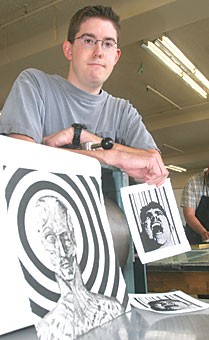Who: Installation/mixed media artist Alan Skees
Bio: Skees was born and raised in Birmingham, Ala. Skees is a third-year graduate student working on his masters in studio art with a focus on printmaking.
What: “”Coded,”” an exhibit in the Lionel Rombach Gallery Oct. 2 through Oct. 13, is an installation of cut black vinyl Skees used to make bar coded images of himself and other people.
Wildcat: What inspires you?
Skees: I’m inspired by old masters and pop culture. I like the technicality of the old masters as well as new up and coming technology that you can use and abuse to make your own artwork. In this one I’m referencing everything from Warhol to Da Vinci.
W: What art inspires you?
S: I like a lot of (Andy) Warhol’s methods. He was using quick, disposable forms of artwork. That also plays into the barcode imagery. I’m using people as a commodity in this show. They’re only worth the amount of numerical baggage that they have. I’m sort of looking at those sort of disposable numbers that change with a disposable media. Once I finish the show it goes straight into the trash. I can reproduce it, though. I can reproduce it exactly.
W: Is that part of what makes you unique?
S: Right now I’m sort of just working on disposable artwork. I don’t know if it’s unique in our culture now. On a long-term basis it’s unique, if you look at the artwork as a whole it is. We’ve got original Rembrandts hanging around, but this is something that you could find in a landfill, but since it’s plastic you won’t be able to figure it out. I am focusing on the disposable nature of art. It is unusual but not really. It’s been going on since the ’60s, this sort of disposable artwork.
W: What mediums do you work with?
S: I’m a mixed media artist. I’m not a traditional art maker. I’m always looking for new technology to work with. I’ve worked in large-format prints. I’ve worked with lithographs, and I’ve done sculpture. Last October, I had a large-scaled sculpture in Australia, which was part of the “”Sculpture by the Sea”” show. We were one of three American design teams that got their exhibit there.
W: When did you start working with art?
S: I started back in undergraduate school. My school was the University of Alabama in Birmingham. I had the luck and opportunity to work with Derek Cracco. He really got me working in it. He does everything from digital frescoes to sort of bizarre print techniques that most people haven’t heard about. I was in graphic design, and then I was working with different mediums and graphic design, and in printmaking I found that I could use all of my graphic design skills. I’m very mixed media.
W: What is your favorite piece?
S: I really like an older piece that I have in the show. It’s sort of what got me doing these large-scale mural pieces. I did it a year ago. It is vinyl, bar-coded fragments of people’s faces. I could install it in a different combo of people’s faces, a grown man’s eyes going with the lower half of a little girl’s face. I could swap them out and transfigure the installation at will. I enjoy working on that piece, and that’s what kicked off this idea of full-scale bar coded human bodies. They’re more self-portraits than anything. They’re pictures of me that are broken down. I’m wearing black and white coveralls, to go with the idea of conformity. They looked like a cage, like I’m becoming part of the bar code.
W: Do you like Tucson?
S: Since my wife and I are both from the South, we were looking for a place that doesn’t get much snow. We moved across the country and started graduate school in the same month. We knew some people out here. I really like the campus a lot. The community is nice as well. I’ve made good friends here.









